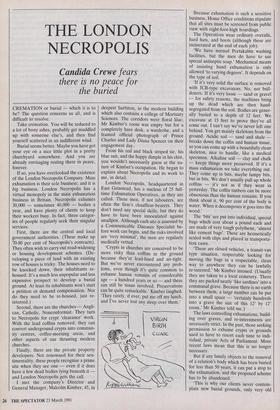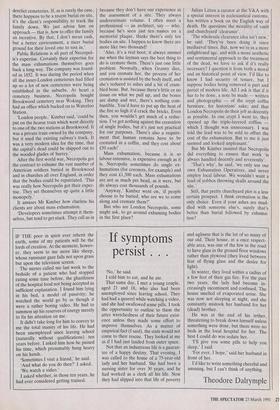THE LONDON NECROPOLIS
Candida Crewe fears
there is no peace for the buried
CREMATION or burial — which it is to be? The question concerns us all, and is difficult to resolve.
Take cremation. You will be reduced to a lot of bony ashes, probably get muddled up with someone else's, and then find yourself scattered in an indifferent wind. Burial seems better. Maybe you have got your eye on a nice little plot in a pretty churchyard somewhere. And you are already envisaging resting there in peace, forever.
If so, you have overlooked the existence of the London Necropolis Company. Mass exhumation is their sole business; and it is big business. London Necropolis has a virtual monopoly in the mass exhumation business in Britain. Necropolis exhumes 30,000 — sometimes 40,000 — bodies a year, and have plenty of clients to keep their workers busy. In fact, three categor- ies of people regularly seek their singular services.
First, there are the central and local government authorities. (These make up 70-80 per cent of Necropolis's contracts). They often wish to carry out road-widening or housing development schemes. (De- veloping a piece of land with an existing row of houses is tricky. The houses need to be knocked down, their inhabitants re- housed. It's a much less unpopular and less expensive prospect to develop a burial ground. At least its inhabitants won't start a petition or demand compensation. Nor do they need to be re-housed, just re- interred.) Second, there are the churches — Angli- can, Catholic, Nonconformist. They turn to Necropolis for crypt 'clearance' work. With the lead coffins removed, they can convert underground crypts into commun- ity centres, coffee-morning areas, and other aspects of our thrusting modern churches.
Finally, there are the private property developers. Not renowned for their sen- timentality, these people recognise a prime site when they see one — even if it does have a few dead bodies lying beneath it — and London Necropolis gets the call.
I met the company's Director and General Manager, Malcolm Kimber, 45, in deepest Surbiton, in the modern building which also contains a college of Mortuary Sciences. The corridors were floral lilac; Mr Kimber's room was empty but for a completely bare desk, a wardrobe, and a framed official photograph of Prince Charles and Lady Diana Spencer on their engagement day.
From his red and black striped tie, his blue suit, and the happy dimple in his chin, you wouldn't necessarily guess at the na- ture of Kimber's occupation. He began to explain about Necropolis and its work to me, in detail.
London Necropolis, headquartered in East Grinstead, has a nucleus of 25 full- time Exhumation Operatives, as they are called. These men, if not labourers, are often the firm's chauffeur-bearers. They don't need any special skills, but they do have to have been innoculated against smallpox. Although each site is assessed by a Communicable Diseases Specialist be- fore work can begin, and the risks involved are 'very minimal', the men are regularly medically vetted.
'Crypts in churches are conceived to be more risky than coffins in the ground because they're lead-lined and air-tight. But we've never encountered any prob- lems, even though it's quite common to exhume human remains of considerable age — a hundred years or so — and there can still be tissue involved. Preservations can be quite remarkable.' Kimber laughed. 'They rarely, if ever, put me off my lunch, and I've never lost any sleep over them.' Because exhumation is such a sensitive business, Home Office conditions stipulate that all sites must be screened from public view with eight-foot-high hoardings.
The Operatives wear ordinary overalls, hard hats, and boots (although these are incinerated at the end of each job).
'We have normal Portakabin washing facilities, but the men do have to use special antiseptic soap.' Mechanical means of assisting hand exhumation is only allowed 'to varying degrees'. It depends on the type of soil.
'If it's very solid the surface is removed with JCB-type excavators. No, not bull- dozers. If it's very loose — sand or gravel — for safety reasons, the machines bring up the dead which are then hand- segregated from the soil. Bodies are gener- ally buried to a depth of 12 feet. We excavate at 15 feet to prove they've all come out. I can't say we've never left one behind. You get mainly skeletons from the ground. Acidic soil — sand and shale — breaks down the coffin and human tissue, so you can come up with a beautifully clean skeleton, nice to handle, like a medical specimen. Alkaline soil — clay and chalk — keeps things more preserved. If it's a mass exhumation we take everything out. They come up in bits, maybe lumpy bits, but in bits. We don't usually pull up whole coffins — it's not as if they went in yesterday. The coffin timbers can be more obnoxious than the human remains. If you think about it, 90 per cent of the body is water. When it decomposes it goes into the wood.'
The 'bits' are put into individual, special bags which cost about a pound each and are made of very tough polythene, 'almost like cement bags'. These are hermetically sealed with clips and placed in transporta- tion cases.
'These are closed vehicles, a transit-van type situation, respectable looking for moving the bags in a respectable, clean way to anywhere they can be lawfully re-interred.' Mr Kimber intoned. (Usually they are taken to a local cemetery. There they are packed neatly 'like sardines' into a communal grave. Because there is no earth between them, a large number can be put into a small space — 'certainly hundreds into a grave the size of this 12' by 12' room,' Mr Kimber told me.) The laws controlling exhumations, build- ing over graves, and re-internments are necessarily strict. In the past, those seeking permission to exhume crypts or grounds used to have to resort each time to indi- vidual, private Acts of Parliament. More recent laws mean that this is no longer necessary.
But if any family objects to the removal of a relation's body which has been buried for less than 50 years, it can put a stop to the exhumation, and the proposed scheme has to be abandoned.
'This is why our clients never contem- plate new burial grounds, only very old derelict cemeteries. If, as is rarely the case, there happens to be a recent burial on site, it's the client's responsibility to track the family down. We just advise him on approach — that is, how to offer the family an incentive. By that, I don't mean cash, but a better environment, a nicer burial ground for their loved one to rest in.' Public Relations is all part of Necropol- is's expertise. Certainly their expertise for the mass exhumations themselves goes back a long way. The company was found- ed in 1852. It was during the period when all the inner-London cemeteries had filled up so a lot of new cemeteries were being established in the suburbs. At heart a cemetery business, Necropolis bought Brookwood cemetery near Woking. They had an office which backed on to Waterloo Station.
'London people,' Kimber said, 'could be put on the hearse train which went directly to one of the two stations at Brookwood. It was a private train owned by the company, but it used the existing railway's track. It was a very modern idea for the time, that the capital's dead could be shipped out to the wooded glades of Surrey.' After the first world war, Necropolis got the contract to exhume the vast number of American soldiers buried in Brookwood and in churches all over England, in order that the bodies could be repatriated. 'This was really how Necropolis got their exper- tise. They set themselves up quite a little monopoly.' It amuses Mr Kimber how clueless his clients are about mass exhumation.
'Developers sometimes attempt it them- selves, but tend to get stuck. They call us in because they don't have our experience in the assessment of a site. They always underestimate volume. I often meet a professional — an architect, say — who, because he's seen just ten names on a memorial plaque, thinks there's only ten bodies on site. I happen to know there are more like two thousand!
'Also, it's a real hoot, it always amuses me when the layman says the best thing to do is cremate them. There's just one little problem. Normally, when Granny dies, and you cremate her, the process of her cremation is assisted by the body itself, and she's reduced to ashes and a bit of crum- bled bone. But, because there's little or no tissue on what we pull up, and the bones are damp and wet, there's nothing com- bustible. You'd have to put up the heat of the fire so high it'd crack the bricks. Even then, you wouldn't get much of a reduc- tion. I've got nothing against the cremation of single bodies, but it's just not practical for our purposes. There's also a require- ment that human remains have to be cremated in a coffin, and they cost about £50 each!'
Mass exhumation, because it is so labour-intensive, is expensive enough as it is. Necropolis sometimes do single ex- humations (for coroners, for example) and they cost £1,500 each. Mass exhumations are not as much per head, as it were, but do always cost thousands of pounds.
'Anyway,' Kimber went on, `if people choose to be buried, who are we to come along and cremate them?'
But who are London Necropolis, some might ask, to go around exhuming bodies in the first place? Julian Litten a curator at the V&A with a special interest in ecclesiastical customs, has written a book on the English way of death. He questions the morality of vault and churchyard 'clearance'.
'The wholesale clearance idea isn't new,' he said. 'They've been doing it since mediaeval times. But, now we're in a more enlightened age, and with a more aesthetic and sentimental approach to the treatment of the dead, we have to ask if it's really necessary? I question it from both a moral and an historical point of view. I'd like to know I had security of tenure, but I suppose bodies being removed is part and parcel of modern life. All I ask is that if it has to be done, a note be made — written and photographic — of the crypt coffin furniture, for historians' sake; and that London Necropolis do their job as decently as possible. In one crypt I went to, they opened up the triple-layered coffins — which I thought was unnecessary. I was told the lead was to be sold to offset the cost of the exhumation. But to me it just seemed and looked unpleasant.'
But Mr Kimber insisted that Necropolis did everything to ensure that work 'is always handled decently and reverently'.
'That's why', he said, 'we only use our own Exhumation Operatives, and never employ local labour. We wouldn't want a load of yobbos throwing skulls around the site.'
Still, that pretty churchyard plot is a less certain prospect. I think cremation is the only choice. Even if your ashes are mud- dled with someone else's, surely that's better than burial followed by exhuma- tion?



























































 Previous page
Previous page